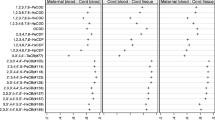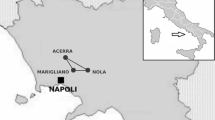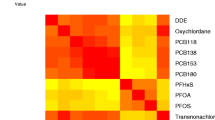Abstract
Whole blood samples were taken from 101 women (26±4 years) entering maternity facilities in upstate New York. At birth, fetal cord blood was also collected. The samples were analyzed for 74 polychlorobiphenyl (PCB) congeners,p,p′-DDE, mirex, and hexachlorobenzene by glass capillary gas chromatography with electron capture detection. Maternal blood contained 3.5±1.1 ng total PCB/g whole blood and fetal cord blood contained 2.4±1.0 ng total PCB/g whole blood, which indicate that the women are less contaminated than women surveyed elsewhere in the U.S. Of the 77 compounds measured, only 20 occurred in more than 10% of the maternal samples at levels >0.01 ng/g. Mirex was not detected. Although the concentration of the majority of congeners,p,p′-DDE and hexachlorobenzene correlated in maternal and fetal cord blood, 2,5,2′,5′-tetrachlorobiphenyl and hexachlorobenzene crossed the placenta preferentially. Apparently, the population contains vestiges of Aroclor® 1242 (the PCB mixture used in electrical equipment) and Aroclor® 1260 (the mixture used as a plasticizer).p,p′- DDE was the pollutant present at highest concentration (maternal 3.8±0.8 ng/g, fetal cord 1.9±0.9 ng/g).
Similar content being viewed by others
References
Afifi AA, Azen SP (1972) Statistical analysis—A computer oriented approach. Academic Press, New York. 65 pp
Albro WP, Haseman JK, Chemmer TA, Corbett BJ (1977) Identification of individual polychlorinated biphenyls in a mixture by gas-liquid chromatography. J Chromatgr 136:147–153
Albro PW, Corbett JT, Schroeder JL (1981) Quantitative characterization of polychlorinated biphenyl mixtures (Aroclors 1248, 1254 and 1260) by gas chromatography using capillary columns. J Chromatgr 205:103–111
Baker EL, Landrigan PJ, Glueck CJ, Zack MM, Liddle JA, Burse VW, Housworth WJ, Needham L (1980) Metabolic consequences of exposure to polychlorinated biphenyls (PCB) in sewage sludge. Am J Epidemiol 112:553–563
Baker FD, Bush B, Tumasonis CF, Lo FC (1977) Toxicity and persistence of low-level PCB in adult Wistar rats, fetuses, and young. Arch Environ Contam Toxicol 5:143
Ballschmitter K, Zell M (1980) Analysis of polychlorinated biphenyls (PCB) by glass capillary gas chromatography. Fresinius Z Anal Chem 302:20–31
Bergman A, Brandt I, Darnerud PO, Wachtmeister CA (1982) Metabolism of 2,2′,5,5′-tetrachlorobiphenyl: formation of mono- and bis-methyl sulphone metabolites with a selective affinity for the lung and kidney tissue in mice. Xenobiotica 12:1–7
Bowman RE, Heironimus MP (1981) Hypoactivity in adolescent monkey perinatally exposed to PCBs and hyperactive as juveniles. Neurobeh Toxicol Teratol 3:15–18
Brandt I, Bergman DA, Larsson J (1982) Metabolism of 2,4′,5-trichloro-biphenyl: enrichment of hydroxylated and methyl sulphone metabolites in the uterine luminal fluid of pregnant mice. Chem Biol Interact 40:45–56
Brown DP, Jones M (1981) Mortality and industrial hygiene study of workers exposed to PCBs. Arch Environ Health 36:120–129
Bush B, Tumasonis CF, Baker FD (1974) Toxicity and persistence of PCB homologs and isomers in the avian system. Arch Environ Contam Toxicol 2:195–209
Bush B, Connor S, Snow J (1982) Glass capillary gas chromatography for sensitive, accurate polychlorinated biphenyl analysis. J Assoc Off Anal Chem 65:555–566
Bush B, Barnard EL (1982) Determination of nonpolar chlorinated hydrocarbons and PCB in microsamples. Anal Lett 15:1643–1648
Bush B, Snow JT, Connor S (1983a) High resolution gas chromatographic analysis of nonpolar chlorinated hydrocarbons in human milk. J Assoc Off Anal Chem 66:248–255
Bush B, Snow JT, Connor S, Rueckert L, Han Y, Dymerski P, Hilker D (1983b) Mirex in human milk in upstate New York. Arch Environ Contam Toxicol 12:739–746
Chen PH, Luo ML, Wong CK, Chen CJ (1982) Comparative rates of elimination of some individual polychlorinated biphenyls from the blood of PCB-poisoned patients in Taiwan. Fd Cosmet Toxicol 20:417–425
Colby BW, Picker JE (1983) Automated recognition of Aroclor GC patterns. Pittsburgh Conference, Atlantic City, NJ, Abstract 574
Diem K, Lentner JC (1970) Scientific Tables, 7th edn. Ciba Geigy Ltd., Basel, Switzerland, p 600
Digernes V, Astrup EG (1982) Are datascan terminals a source of increased PCB-concentrations in the working atmosphere? Int Arch Occup Environ Health 49:193–197
Dixon WJ (Chief Editor) (1981) BMDP Statistical Software. University of California Press, Berkeley, California
Forgue ST, Allen JR (1982) Identification of an arene oxide metabolite of 2,2′,5,5′-tetrachlorobiphenyl by gas chromatography-mass spectroscopy. Chem Biol Interact 40:233–285
Frank R, Thomas RL, Holdrinet M, Kemp ALW, Braun HE (1979) Organochlorine insecticides and PCB in surficial sediments (1968) and sediment cores (1976) from Lake Ontario. J Great Lakes Res 5:18–27
Horn EG, Hetling LJ, Tofflemire TJ (1979) The Problem of PCB's in the Hudson River System. Ann NY Acad Sci 320:591–609
Jensen S, Sundstrom G (1974) Structure and levels of most chlorobiphenyls in two technical PCB products and in human adipose tissue. Ambio 3:70–75
Kato S, McKinney JD, Matthews HB (1980) Metabolism of symmetrical hexachlorobiphenyl isomers in the rat. Toxicol Appl Pharmacol 53:389–398
Kimbrough RD (1981) Chronic toxicity of halogenated biphenyls and related compounds in animals and health effects in humans. Toxicology of Halogenated Hydrocarbons: Health and Ecological Effects. Khan MHQ, Stanton RH (eds) Pergamon Press, New York, pp 23–37
Kreiss K, Zack MM, Kimbrough RD (1981) Association of blood pressure and polychlorinated biphenyl levels. J Am Med Assoc 245:2505–2509
Kuroki H, Masuda Y (1977) Structure and concentrations of the main components of polychlorinated biphenyls retained in patients with Yusho. Chemosphere 8:469–474
Linder RE, Gaines TB, Kimbrough RD (1974) The effect of polychlorinated biphenyls on rat reproduction. Fd Cosmet Toxicol 12:63–77
Lutz RJ, Dedrick RL, Matthews HB, Eling TE, Anderson MW (1977) A preliminary pharmacokinetic method for several chlorinated biphenyls in the rat. Drug Metab Disp 5:386–396
Masuda Y, Yoshimura H (1982) Chemical analysis of polychlorinated biphenyls and dibenzofuran in relation to Yusho. J Toxicol Sci 12:161–175
Matthews HB, Tuey DB (1980) The effect of chlorine position on the distribution and excretion of four hexachlorobiphenyl isomers. Toxicol Appl Pharmacol 53:377–388
Needham LL (1981) Polychlorinated biphenyl determination at parts-per-billion level in serum. CDC Laboratory Update 81-108. US Department of Health and Human Services, Atlanta, Georgia
Norstrom RJ, Gilman AP, Hallet DJ (1981) Total organically bound chlorine and bromine in Lake Ontario Herring Gull Eggs, 1977, by instrumental, neutron activation, and chromatographic methods. Sci Total Environ 20:217–230
O'Keefe P, Meyer C, Hilker D, Aldous K, Jeluss-Tyror B, Dillon K, Donnelly R, Horn E, Sloan R (1982) Analysis of 2,3,7,8-tetrachlorodibenzo-p-dioxin in Great Lakes fish. Chemosphere 12:325–332
Rappe C, Buser HR, Stalling DL, Smith LM, Dougherty RC (1981) Identification of polychlorinated dibenzofurans in environmental samples. Nature 292:524–526
Richardson A, Robinson J, Bush B, Davies JM (1967) Determination of dieldrin (HEOD) in blood. Arch Environ Health 14:703–708
Safe SA, Parkinson L, Cockerline R, Safe L (1981) PCBs as microsomal enzyme inducers: structure-activity rules. Toxicity of halogenated hydrocarbons: health and ecological effects. Khan MHQ, Stanton RH (eds) Pergamon Press, New York, pp 23–37
Schwartz PM, Jacobson SW, Fein G, Jacobson JL, Price HA (1983) Lake Michigan fish consumption as a source of polychlorinated biphenyls in human cord serum, maternal serum and milk. Am J Public Health 73:293–296
Sissons D, Welti D (1971) Structural identification of polychlorinated biphenyls in commercial mixtures by gas chromatography. J Chromatogr 60:15–32
Sommer DA, Striber DA, Bradley RL, Peterson RE (1982) Raising marketable Yellow Perch on a polychlorinated biphenyl contaminated diet: A feasibility study for the perch aquaculture industry. Arch Environ Contam Toxicol 11:589–593
Spagnoli J, Skinner L (1977) PCBs in fish from selected waters of New York State. Pest Monit J 11:69–87
Storm JE, Hart JL, Smith RF (1981) Behavior of mice after pre- and post-natal exposure to Aroclor 1254. Neurobeh Toxicol and Teretol 3:5–9
Tuistra LGMT, Traag WA, Keukens HJ (1980) Qualitative determination of individual chlorinated biphenyls in milk fat by splitless glass capillary gas chromatography. J Assoc Off Anal Chem 63:952–958
Tumasonis CF, Bush B, Baker FD (1973) PCB levels in egg yolks associated with embryonic mortality and deformity of hatched chicks. Arch Environ Contam Toxicol 1:312–323
Webb RG, McCall AC (1973) Quantitative PCB standards for electron capture gas chromatography. J Chem Soc 11:366–373
Welch BC (1937) The significance of the differences between two means when the population variances are unequal. Biometrika 29:350–362
Wold S, Dunn III, WJ (1983) Multivariate quantitative structure-activity relationships (QSAR): conditions for their applicability. J Chem Inf Comput Sci 23:6–13
Wolfe MS, Thornton J, Fischbein A, Likis R, Selikoff IJ (1982) Disposition of polychlorinated biphenyl congeners in occupationally exposed persons. Toxicol Appl Pharmacol 62:294–306
Yakushiji T, Watawabe I, Kowabara K, Yoshida S (1978) Identification of low chlorinated biphenyls in human milk by gas chromatography-mass spectrometry. J Chromatogr 154:203–210
Author information
Authors and Affiliations
Rights and permissions
About this article
Cite this article
Bush, B., Snow, J. & Koblintz, R. Polychlorobiphenyl (PCB) congeners,p,p′-DDE, and hexachlorobenzene in maternal and fetal cord blood from mothers in upstate New York. Arch. Environ. Contam. Toxicol. 13, 517–527 (1984). https://doi.org/10.1007/BF01056331
Received:
Revised:
Issue Date:
DOI: https://doi.org/10.1007/BF01056331




